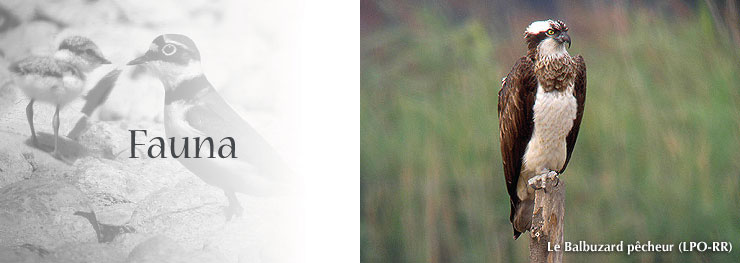 |
|
|
A few figures will suffice to give a general survey of this extraordinary abundance. Thus, along a ten-kilometre alluvial stretch of the Allier, with a relatively protected eco-system, it is possible to find: The Upper Allier displays a smaller number of species, but some of them are of great interest in heritage terms, and are only to be found in the gorges of the river (White-Clawed Crayfish, Dipper, Peregrine Falcon). |
1- After decades of absence, Beavers were reintroduced to the Loire basin in 1974, near to Blois, using animals from the Rhône basin. Starting from this small population, Beavers have recolonized the more favourable reaches of the Loire and its tributaries, in particular the Lower Allier (Nevers), which they reached in 1986. In 1992, they settled upstream of Moulins, towards Chemilly. Since 1999, they have frequented the Allier in the Brivadois and the alluvial valley of the Alagnon. Thus, in 20 years, Beavers have recolonized the greater part of the Allier of the plains.
2- The Otter disappeared from the alluvial plain of the Allier in the fifties due to water pollution and trapping. Starting from zones where it had survived, in the upper catchments of the Allier, Sioule and Dordogne, it has been winning back its past territories since the mid-eighties. In 1996, it was seen in Puy-de-Dôme towards Maringues and Puy-Guillaume, as well as at the confluence of the Sioule (03). Its natural recolonization still continues: today, Otters have reached Central France and Burgundy. 3- Terns, Little Ringed Plovers, Common Sandpipers and Stone Curlews: these birds nest on all the Allier’s beaches and islets free from vegetation, making them a very unusual group. Common Sandpipers are found in the gorges, but their density declines after Vichy. In contrast, Little Ringed Plovers appear after Brioude and become common after Vichy. Little and Common Terns are only found downstream of Vichy, when islands become larger and more frequent. Stone Curlews are quite exceptional in Auvergne, as they are essentially restricted to the islands in the Allier, though they are usually birds of the plains and steppes! 4- Sand Martins, European Bee-Eaters and Kingfishers are another community of birds native to the Allier Valley. These three species seek banks eroded by the river that form cliffs of loam, sand or gravel in which they can dig out their nesting tunnels. Sand Martins and European Bee-Eaters live in colonies which can reach a considerable size, whereas Kingfishers nest in solitary pairs, occupying a territory of 3 to 4 km of river. Ospreys, also called Fish Eagles, are one of the most eagerly awaited and closely observed migrant birds: watching them fishing is a spectacle that attracts numbers of nature lovers. Rare in Europe, in France they only nest in a few of the large forests around Orleans, and in Corsica. Thus Ospreys are only visitors passing through Auvergne on migration to Northern Europe (Scandinavia, Scotland, etc.). One of the best places in the whole Loire basin to watch them between late March and mid-April, and later on in September, is between Vichy and Moulins. During migration, Osprey density in this section is so high that it is possible to see one at almost every meander. 5- The European Pond Turtle is the only turtle native to Europe. Rare and localized, it is a protected species throughout Europe. In Auvergne, it is mainly found in the ponds of the Sologne area in the Bourbonnais, north of the Department of Allier. Uncommon along the Allier, it only occupies a few cut-off loops between Vichy and downstream of Moulins. There, it displays a good capacity for adaptation, as it colonizes fluctuating systems that can dry up in summer. European Turtles are currently threatened by illegal releases of exotic "pet" turtles, which are serious competition for the native species. The Green Snaketail is one of the most remarkable of the many species of dragonfly found on the Allier. Indeed, the Loire and Allier catchments harbour the largest population in France of this species, which is under serious threat in Europe. Recognizable by its luminous green and yellow coloration, this fairly large dragonfly lives close to the Allier, frequenting the alluvial forests for its food supply. Its larvae develop in the main channel, close to the banks. Covered by the Natura 2000 network, the Green Snaketail is also protected throughout France. |












 Fauna
Fauna